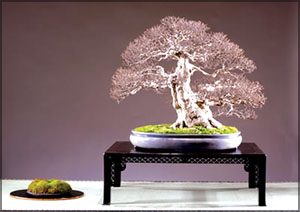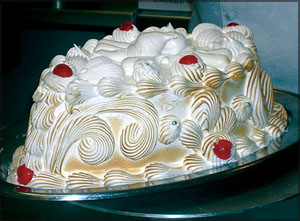|

Bonsai:
An ancient art growing in popularity
 What is bonsai? It is the ancient art of producing miniature trees.
The trees themselves are called bonsai. Look at the pictures given on
this page. Showing different dwarf trees. Bonsai's range in height from
a few inches to about two feet. What is bonsai? It is the ancient art of producing miniature trees.
The trees themselves are called bonsai. Look at the pictures given on
this page. Showing different dwarf trees. Bonsai's range in height from
a few inches to about two feet.
In the Grade 8 English Pupils' Book, on page 17, there are a few
facts about bonsai. Two students who had been told by their teacher to
write a short essay on bonsai, asked me for more information. There may
be others, I am sure, who would like to know more about this art of
growing miniature trees.
Bonsai is an art (believed to have originated in China) that the
Japanese have perfected, over the centuries. The first records of
dwarfed, potted plants in Japan is in a picture scroll (roll of paper or
parchment) done in 1309, that is 700 years ago.
So, it is likely that the Japanese had been cultivating dwarf plants
for a 100 or more years before that scroll of pictures was made by one
Takashino Takakane in 1309.
Bonsai is becoming a popular pastime in Sri Lanka, as in many other
countries. In Japan it is not only a pastime; it is part of the nursery
industry. Bonsais are for sale in nurseries along with other plants and
trees.
Bonsais are ordinary trees dwarfed by pruning roots and branches, and
tying the branches with wire, to restrict growth, and also to bend them
into the correct shape, that is the natural shape of the ordinary tree.
 The Japanese plant a seedling or a rooted cutting of such trees as
pine juniper, maple or azalea. The Japanese plant a seedling or a rooted cutting of such trees as
pine juniper, maple or azalea.
In Sri Lanka, I have seen bonsai bo trees and dwarfed mango and
pomegranate trees growing in pots.
Pruning roots and stems is not enough to restrict the tree to
miniature size. New shoots must be nipped during the growing season and
the plant must be re-potted from time to time.
Before re-potting, the roots have to be pruned. When the roots are
pruned periodically, the "soil ball" holding the roots will get smaller
and fit the container; it can then be grown in the same container for
years. Once the tree has been dwarfed to the desired height, it can be
kept in the same pot or tray.
The time taken to cultivate a bonsai to the desired size varies. It
takes 5-10 years training (pruning, tying branches with wire and nipping
of new shoots) to get a tree that is about 5 cm (2 inches) in height. A
bonsai of medium height - 6 to 12 inches - can be cultivated in three
years.
Bonsai trees are hardy. They can live over 100 years. Some Japanese
families hand down bonsai trees from generation to generation as valued
family possessions - heirlooms. In Japanese homes bonsai is displayed in
their living rooms on small low tables or in alcoves (that part in the
wall that is further back from the rest).
The aged appearance of the trunk and branches and the weathered look
in the exposed upper roots are features highly prized in a bonsai tree.
The Japanese say these aesthetic qualities in the bonsai trees are a
reminder that all things change. It is the same concept as anicca in
Buddhism-nothing remains the same for ever; everything changes.
The Japanese word bonsai means 'tray-planted', bonsai is very often
grown in wooden trays. The container in which the tree is planted in, is
very important in this art of growing dwarf or miniature trees.
 The container can be of wood or clay. It can be round, oval, square,
rectangular or even octagonal and it must have a hole in the bottom. But
it must be selected to suit the tree planted there in. It must
complement (add to) the colour and the shape of the tree when it grows
to the desired height. The container can be of wood or clay. It can be round, oval, square,
rectangular or even octagonal and it must have a hole in the bottom. But
it must be selected to suit the tree planted there in. It must
complement (add to) the colour and the shape of the tree when it grows
to the desired height.
The placing of the seedling or the rooted cutting in the container is
another important factor. The shape of the tree when it grows must be
considered. Most trees have branches spreading all round. In some trees
branches hang down like cascades. Pine trees are cone-shaped.
The bonsai trees are watered as frequently as other plants.
Liquid fertiliser is also used. As bonsais are hardy plants they can
be left outdoors if the weather is not too cold or if there is no rain.
Sumana Saparamadu
Women hold up half the sky
 More than half of Sri Lanka’s population comprise women, as you may
already know. It is also quite a well-known fact that they make an
invaluable contribution to keeping the island’s economy afloat. More than half of Sri Lanka’s population comprise women, as you may
already know. It is also quite a well-known fact that they make an
invaluable contribution to keeping the island’s economy afloat.
 Despite these facts, women and girl children continue to recieve the
short end of the stick when it comes to many fields. The basic rights
that they are entitled to - such as food, education and security - are
denied to them while they also have to encounter a lot of violence when
making their way in society. Despite these facts, women and girl children continue to recieve the
short end of the stick when it comes to many fields. The basic rights
that they are entitled to - such as food, education and security - are
denied to them while they also have to encounter a lot of violence when
making their way in society.
The issues concerning women and girl children are highlighted on
March 8 every year, on the United Nations Day for Women’s Rights and
International Peace, generally known as International Women’s Day (IWD),
an event that is celebrated around the world including Sri Lanka.
This year’s event would be conducted under the theme ‘Shaping
progress’ and would comprise over 250 different events. They would range
from small and informal events organised on a random basis to large,
highly-organised events.
Another important factor regarding IWD this year is that we are only
three years away from the centenary of this leading event officially
launched in 1911.
Although the first IWD was held on February 28, 1909 in the USA, it
was officially recognised at the first international women’s conference,
held in Copenhagen, Denmark by Socialist International in 1911. It was
marked the following year by over one million people, both men and
women, in Austria, Denmark, Germany and Switzerland.
The day also commemorates the Triangle Shirtwaist factory fire in New
York in 1911, where over 140 women workers died due to the lack of
safety measures. On March 8, 1913, women across Europe organised peace
rallies against World War I. The event was revived during the 1960s.
In 1975, which had been designated as the International Women’s Year,
the United Nations officially sanctioned and began sponsoring the Day.
Celebrations on an international scale got under way in 1977.
The goals of the annual event are to celebrate the progress made to
advance equality for women and to assess the challenges that remain.
It’s a major event which honours and acknowledges the economic, social
and political achievements made by women around the world.
Ice cream baked inside a cake
We all love good food especially delicious desserts. An unusual
dessert, which makes an appearance around Christmas time, is Baked
Alaska.
 Have you ever wondered why this lovely dish is known as such? Alaska
is a part of the United States...the 49th state to be exact. How can you
bake a part of a country? Read on and see. Have you ever wondered why this lovely dish is known as such? Alaska
is a part of the United States...the 49th state to be exact. How can you
bake a part of a country? Read on and see.
Baked Alaska is made of ice cream placed in a pie dish lined with
slices of sponge cake or Christmas pudding and topped with meringue. Now
you may be wondering how exactly ice cream is baked.
The dish is kept in the freezer until serving time, then it is placed
in a very hot oven, just long enough to firm and brown the meringue.
Some use a small blowtorch to brown the meringue, which acts as an
effective insulator, and the short cooking time prevents the heat from
melting the ice cream.
The idea of baking a dessert with ice cream at its core seems to have
originated with the Chinese, who used pastry instead of meringue for the
casing. It was introduced to Europe in the mid-19th century when a
Chinese delegation visited Paris.
The use of meringue was introduced in 1804 by the American physicist
Benjamin Thompson, who investigated the heat resistance of beaten egg
whites; he found that while pastry would conduct the heat to the ice
cream, beaten egg whites would do so to a lesser extent.
The dish was named glace au four, omelette surprise, omelette a la
norvegienne and Norwegian omelette; the Norwegian part being used due to
its Arctic appearance and cold centre. It was renamed ‘Baked Alaska’ in
1876 when Delmonico’s Restaurant in New York City named it in honour of
the newly acquired territory of Alaska.
The dessert was popularised worldwide by the chef Jean Giroix in 1895
at the Hotel de Paris in Monte Carlo. The process was simplified in 1974
by Jacqueline Halliday Diaz who invented a special baking pan with a
fillable hollow.
In 1969, the microwave oven enabled Hungarian physicist and
‘molecular gastronomist’ Nicholas Kurti to produce a ‘reverse Baked
Alaska’ (Frozen Florida), which was hot on the inside and cold on the
outside.
Many variations of this dessert are now being made with fillings like
raspberry being used instead of ice cream. However it may be made, it
sure is a heavenly dessert. |
